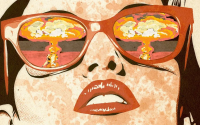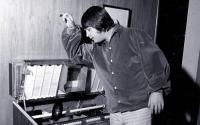17 April 2005 By David Keys and Nicholas Pyke
For more than a century, it has caused excitement and frustration in equal measure - a collection of Greek and Roman writings so vast it could redraw the map of classical civilisation. If only it was legible.
Now, in a breakthrough described as the classical equivalent of finding the holy grail, Oxford University scientists have employed infra-red technology to open up the hoard, known as the Oxyrhynchus Papyri, and with it the prospect that hundreds of lost Greek comedies, tragedies and epic poems will soon be revealed.
In the past four days alone, Oxford's classicists have used it to make a series of astonishing discoveries, including writing by Sophocles, Euripides, Hesiod and other literary giants of the ancient world, lost for millennia. They even believe they are likely to find lost Christian gospels, the originals of which were written around the time of the earliest books of the New Testament.
The original papyrus documents, discovered in an ancient rubbish dump in central Egypt, are often meaningless to the naked eye - decayed, worm-eaten and blackened by the passage of time. But scientists using the new photographic technique, developed from satellite imaging, are bringing the original writing back into view. Academics have hailed it as a development which could lead to a 20 per cent increase in the number of great Greek and Roman works in existence. Some are even predicting a "second Renaissance".
Christopher Pelling, Regius Professor of Greek at the University of Oxford, described the new works as "central texts which scholars have been speculating about for centuries".
Professor Richard Janko, a leading British scholar, formerly of University College London, now head of classics at the University of Michigan, said: "Normally we are lucky to get one such find per decade." One discovery in particular, a 30-line passage from the poet Archilocos, of whom only 500 lines survive in total, is described as "invaluable" by Dr Peter Jones, author and co-founder of the Friends of Classics campaign.
The papyrus fragments were discovered in historic dumps outside the Graeco-Egyptian town of Oxyrhynchus ("city of the sharp-nosed fish") in central Egypt at the end of the 19th century. Running to 400,000 fragments, stored in 800 boxes at Oxford's Sackler Library, it is the biggest hoard of classical manuscripts in the world.
The previously unknown texts, read for the first time last week, include parts of a long-lost tragedy - the Epigonoi ("Progeny") by the 5th-century BC Greek playwright Sophocles; part of a lost novel by the 2nd-century Greek writer Lucian; unknown material by Euripides; mythological poetry by the 1st-century BC Greek poet Parthenios; work by the 7th-century BC poet Hesiod; and an epic poem by Archilochos, a 7th-century successor of Homer, describing events leading up to the Trojan War. Additional material from Hesiod, Euripides and Sophocles almost certainly await discovery.
Oxford academics have been working alongside infra-red specialists from Brigham Young University, Utah. Their operation is likely to increase the number of great literary works fully or partially surviving from the ancient Greek world by up to a fifth. It could easily double the surviving body of lesser work - the pulp fiction and sitcoms of the day.
"The Oxyrhynchus collection is of unparalleled importance - especially now that it can be read fully and relatively quickly," said the Oxford academic directing the research, Dr Dirk Obbink. "The material will shed light on virtually every aspect of life in Hellenistic and Roman Egypt, and, by extension, in the classical world as a whole."
The breakthrough has also caught the imagination of cultural commentators. Melvyn Bragg, author and presenter, said: "It's the most fantastic news. There are two things here. The first is how enormously influential the Greeks were in science and the arts. The second is how little of their writing we have. The prospect of having more to look at is wonderful."
Bettany Hughes, historian and broadcaster, who has presented TV series including Mysteries of the Ancients and The Spartans, said: "Egyptian rubbish dumps were gold mines. The classical corpus is like a jigsaw puzzle picked up at a jumble sale - many more pieces missing than are there. Scholars have always mourned the loss of works of genius - plays by Sophocles, Sappho's other poems, epics. These discoveries promise to change the textual map of the golden ages of Greece and Rome."
When it has all been read - mainly in Greek, but sometimes in Latin, Hebrew, Coptic, Syriac, Aramaic, Arabic, Nubian and early Persian - the new material will probably add up to around five million words. Texts deciphered over the past few days will be published next month by the London-based Egypt Exploration Society, which financed the discovery and owns the collection.
A 21st-century technique reveals antiquity's secrets
Since it was unearthed more than a century ago, the hoard of documents known as the Oxyrhynchus Papyri has fascinated classical scholars. There are 400,000 fragments, many containing text from the great writers of antiquity. But only a small proportion have been read so far. Many were illegible.
Now scientists are using multi-spectral imaging techniques developed from satellite technology to read the papyri at Oxford University's Sackler Library. The fragments, preserved between sheets of glass, respond to the infra-red spectrum - ink invisible to the naked eye can be seen and photographed.
The fragments form part of a giant "jigsaw puzzle" to be reassembled. Missing "pieces" can be supplied from quotations by later authors, and grammatical analysis.
Key words from the master of Greek tragedy
Speaker A: . . . gobbling the whole, sharpening the flashing iron.
Speaker B: And the helmets are shaking their purple-dyed crests, and for the wearers of breast-plates the weavers are striking up the wise shuttle's songs, that wakes up those who are asleep.
Speaker A: And he is gluing together the chariot's rail.
These words were written by the Greek dramatist Sophocles, and are the only known fragment we have of his lost play Epigonoi (literally "The Progeny"), the story of the siege of Thebes. Until last week's hi-tech analysis of ancient scripts at Oxford University, no one knew of their existence, and this is the first time they have been published.
Sophocles (495-405 BC), was a giant of the golden age of Greek civilisation, a dramatist who work alongside and competed with Aeschylus, Euripides and Aristophanes.
His best-known work is Oedipus Rex, the play that later gave its name to the Freudian theory, in which the hero kills his father and marries his mother - in a doomed attempt to escape the curse he brings upon himself. His other masterpieces include Antigone and Electra.
Sophocles was the cultured son of a wealthy Greek merchant, living at the height of the Greek empire. An accomplished actor, he performed in many of his own plays. He also served as a priest and sat on the committee that administered Athens. A great dramatic innovator, he wrote more than 120 plays, but only seven survive in full.
Last week's remarkable finds also include work by Euripides, Hesiod and Lucian, plus a large and particularly significant paragraph of text from the Elegies, by Archilochos, a Greek poet of the 7th century BC.
http://news.independent.co.uk/world/science_technology/story.jsp?story=630165






